Lets begin with the find at Gobekli Tepe: Notice how the figurine is in a seated position with an animal on one shoulder (with possible indications of there having - at one time - been another animal on the other shoulder) and these animals are not depicted as animals of the hunt but rather, as a shaman would describe it, as "allies" or friends;
A Short Note on a New Figurine Type from Göbekli Tepe
The motif of the figurine is an ithyphallic person sitting with legs dragged toward his body on an unidentifiable object. He is looking up and grasping his legs. Between the legs, a large erect phallus is depicted (Fig. 3), and a quadruped animal is sitting on the person´s left shoulder (Fig. 4). As one half of the figurine has a thick layer of sinter, the question whether there originally was another animal on the other shoulder remains open. The animal species cannot be determined with security neither, but the general form is consistent with depictions of large wildcats or bears at Göbekli Tepe (e.g. Schmidt 1999. 9-10, nr. A8). The material of the sculpture is unusual for the site on the other hand. Nearly all sculptures and figurines so far known from Göbekli Tepe were made from local limestone. The new figurine is most likely made from nephrite [Editor: Nephrite is often used for pendants or amulets and must have been considered a "blessed stone" in some way]. The figurine is perforated crosswise in its lower part. A functional interpretation for this detail is hard to give as one perforation would have sufficed to wear it as a pendant for example. Maybe the figurine was meant to be fixed to a support.
But in contrast to this group, the find discussed here has the animal on the shoulder (or one on each shoulder originally?) as an important characteristic.
The animal is clinging to the shoulder in a crouched position, there is no indication of aggression or attack (Fig. 4), or a reaction of the sitting person. The animal could thus have a completely different meaning. We could be dealing with a more metaphorical relationship between man and animal here.
Extract continues: The other important characteristic of the depiction is the prominent erect phallus. Göbekli Tepe´s iconography is generally nearly exclusively male (e.g. Dietrich and Notroff 2015.85), and the phallus features prominently in several depictions of animals and humans. For example, a headless ithyphallic body is depicted on Pillar 43 amongst birds, snakes and a large scorpion (Schmidt 2006). Although the central pillars of the large enclosures are clearly marked as human through the depiction of arms, hands, and in the case of Enclosure D also items of clothing, their sex is not indicated. An erect phallus however is a prominent feature of the foxes depicted on several of the central pillars. There are also a few phallus sculptures from the site (e.g. Schmidt 1999.9, Plate 2/3-4).
Extract from: Of animals and a headless man. Göbekli Tepe, Pillar 43
While some more reliefs to the left of the scorpion and the bird are hidden by the perimeter wall, to the right of the bird’s neck an especially interesting motif is depicted. Due to damage to the pillar it is not preserved completely, but the representation of a headless human with an erect penis is quite clearly recognizable.
Extract from: A Short Note on a New Figurine Type from Göbekli Tepe
The other important characteristic of the depiction is the prominent erect phallus. Göbekli Tepe´s iconography is generally nearly exclusively male (e.g. Dietrich and Notroff 2015.85), and the phallus features prominently in several depictions of animals and humans. For example, a headless ithyphallic body is depicted on Pillar 43 amongst birds, snakes and a large scorpion (Schmidt 2006). Although the central pillars of the large enclosures are clearly marked as human through the depiction of arms, hands, and in the case of Enclosure D also items of clothing, their sex is not indicated. An erect phallus however is a prominent feature of the foxes depicted on several of the central pillars. There are also a few phallus sculptures from the site (e.g. Schmidt 1999.9, Plate 2/3-4).
The "Trickster God" with an erect phallus! Something to look into. (more connections to Native American mythology - see below)
Joseph Campbell explains further: Down there a large bison bull, eviscerated by a spear that transfixed its anus and emerged through its sexual organ stands before a prostrate man. the latter, (the only crudely drawn figure, and the only human figure in the cave) is rapt in a shamanistic trance. He wears a bird mask; his phallus erect, is pointing at the pierced bull; a throwing-stick lies on the ground at his feet; and beside him stands a wand or staff, bearing on its tip the image of a bird. And then, behind this prostrate shaman, is a large rhinoceros, apparently defecating as it walks away.
There has been a good deal of discussion of this painting among the scholar, and the usual suggestion is that it may represent the scene of a hunting accident. No less an authority than Abbe Breuil himself has supported this opinion, suggesting that the rhino may have been the cause of the disaster. It seems to me certain, however, that, in a cave where pictures are magical and consequently were expected to bring to pass such situations as they represent, a scene of disaster would not have been placed in the crypt, the holy of holies. The man wears a bird mask and has birdlike instead of human hands. He is certainly a shaman, the bird costume and bird transformation being characteristic, as we have already seen, of the lore of shamanism to this day throughout Siberia and North America. - Primitive Mythology, Book 1 Of The Masks Of GodThe connection between the birdman with the erect penis from the ancient paleolithic caves to Gobekli Tepe seems pretty straightforward if we were to JUST put it in the category of ancient finds with clear links to shamanism that use similar art in a ritual context (both the Lascaux cave and Gobekli Tepe are considered to have been made for ritual purposes and this could indicate that erect penis art at Gobekli Tepe could represent a future elaboration of the same shamanic theme expressed in the Lascaux cave)
Compare the figure to the much later depiction of Shiva, with the erect penis (& before the later development of the phallus "Shiva" cult) some 5-7 thousand years later from the ruins of Mohenjodaro from what must have been the Saraswati Civilization (now called Indus valley civilization)...
Yoga developed from practices started by Shamans:
"the yogi, as a high transformation of the shamanistic techniques and experiences of ecstasis" Joseph Cambell, Primitive Mythology, Page 437
Notice the animals are different as one would expect from a mythological outlook adapted to local life, but the forms and general meanings/contexts would probably remain the same to SOME extent, the way a burial represents a belief in 'life after death' whatever form the belief may take .i.e. it could be life after death in another world or a reincarnation or whatever. the point is that the idea of an afterlife is indicated by the ritual of a burial and this idea/belief/mythological-outlook goes back - at least - 300,000 years)
An interesting fact is that this ancient seal, from a city that has been dead for around 3000 years, has some amazing similarities between later Hindu, Buddhist and Greek mythology.
"The seated yogi among the beasts wears on his head a curious headdress with a high crown and two immense horns, which, as Heinrich Zimmer has pointed out, resembles to a striking degree on of the so-called "Three Jewels" (symbolizing the Buddha, the doctrine, and the order of the Buddha’s followers), which in the form of a kind of trident. The Hindu god Shiva carries a trident also; and among the Greeks, as we know, this same sign was the attribute of Poseidon (Neptune), the god of the watery deep." Primitive Mythology page 436
Maybe long ago, Poseidon was another version of Shiva. They both carry the Tridents. They both have local animals associated with them (the bull exists in both regions and thus is associated with both, i.e. in the yogi image above the bull is of a local water buffalo species common to northern India). Poseidon;
Poseidon holding a trident. Corinthian plaque, 550-525 BC. From Penteskouphia.
Poseidon became divorced from the yoga/shamanic type practices that seem to characterize India and Gobekli Tepe art indicating a more humanistic/classic Greek approach to the same archetype which seems to have disintegrated over time while in India this archetype still runs strong;
| God of the sea, earthquakes, soil, storms, and horses | |
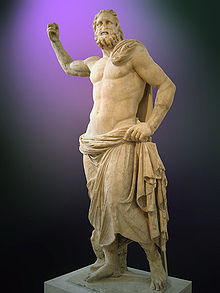
Poseidon from Milos, 2nd century BC (National Archaeological Museum of Athens)
|
Taking a step further into ancient shamanic postures for "journeying" or trance work...
If yogis originate from Shamans and shamnism as Joseph Campbell believes (and evidence seems to indicate)
"the yogi, as a high transformation of the shamanistic techniques and experiences of ecstasis" Joseph Cambell, Primitive Mythology, Page 437
Then meditation or trance - and the postures used for meditation/trance - would go back farther back than we can even imagine. Keeping in mind that the type of meditation may differ from culture to culture but the pose itself would signify meditation/yoga/shamanic-work over 10s of thousands of years through the process of land naming described below, notice these startling synchronicities...
The Shiva of Indus is obviously in a Mulabandhasana pose;
The shaman of 15000 BC s obviously in savana or "corpse" pose....
Wikipedia: Shavasana or mrtasana (death pose)
Here is a screenshot of the figurine (probably a pendant, amulet, of charm of some sort as suggested in the analysis) found at Gobekli Tepe;

Does this mean that the pose found at Gobekli Tepe is a "sitting on a chair" yoga meditation pose or sitting on a throne and meditating (doing shamanic trance activity of some sort)...
... OR a variation of an even more ancient pose used by the mythological Jains called MulaBangha? (by the time these postures reached the modern age, which began about 500 BC, the animals were gone)
This image still brings me the chills as this meditative sitting posture is being found so far back in some form or another, if it can be connected to ancient yoga, would mean that the Jains can probably trace their lineage to Gobekli Tepe if their histories have any element of truth in them!Wikipedia: Attainment of Kevala Jñāna(omniscience) by Mahavira in mulabandhasana posture. Mula bandha has its first literary mention in the oldest Jain canon Acaranga Sutra
A Short Look At Correlations Between Göbekli Tepe And Other Cultures (Includes Observations By Graham Hancock)
Extracts from: A Short Note on a New Figurine Type from Göbekli Tepe
Although the overall form is very similar, the figurines from Mezraa-Teleilat and Çatalhöyük are much more abstracted, the former are sitting on armchair-like seats, wear robe-like clothes and in some cases belts, and examples with animals on the shoulders seem to be missing. As the latest finds from Göbekli Tepe date to the middle PPN B, the figurine must be older than the finds from Mezraa Teleilat and Çatalhöyük.
This difference between Catalhoyuk and Gobekli Tepe could be because of a culture that moved away from animals to plant based or universe based mythology.
Why no animals in the later incarnations of the Gods? Because the forest sages in the most recent millenniums had shifted their attention from the forest (or farm) to the universe itself;
For the primitive hunting peoples of those remotest human millenniums when the sabertooth tiger, the mammoth, and the lesser presences of the animal kingdom were the primary manifestations of what was alien - the source at once of danger, and of sustenance - the great human problem was to become linked psychologically to the task of sharing the wilderness with these beings. An unconscious identification took place and this was finally rendered conscious in the half-human, half-animal, figures of the mythological totem-ancestors. the animals became the tutors of humanity, through acts of literal imitating - such as today appear only on the children's playground (or in the madhouse) - an effective annihilation of the human ego was accomplished and society achieved a cohesive organization. Similarly, the tribes supporting themselves on plant-food became cathected to the plant; the life-rituals of planting and reaping were identified with those of human procreation, birth, and progress to maturity. Both the plant and the animal worlds, however, were in the end brought under social control. Whereupon the great field of instructive wonder shifted - to the skies - and mankind enacted the great pantomime of the sacred moon-king, the sacred sun-king, the hierarchic, planetary state, and the symbolic festivals of the world-regulating spheres. - Joseph Campbell - Extract from the last chapter of "A Hero With A Thousand Faces"
By the time of Gobekli Tepe man had already reached the point where half-human and half animal figures had begun to emerge in their culture and as civilization grew the emphasis changed;
A Short Note on a New Figurine Type from Göbekli Tepe
A total of 149 sculptures has been found to date at Göbekli Tepe. Of these, 86 depict animals, 38 humans, four anthropomorphic masks, three phalli, nine are human-animal composite sculptures and a further nine are indeterminable.
In later Hindu Mythology Half-Human and Half-Animal gods exist which seem connected to this same stratum of mythological thought (notice Ganesha, the elephant headed child in Shiva's lap);
Oleograph by Raja Ravi Varmadepicting a Shiva-centric Panchayatana. A bearded Shiva sits in the centre with his wife Parvati and their infant son Ganesha; surrounded by (clockwise from left upper corner) Ganesha, Devi, Vishnu and Shiva. Shiva's mount is the bull Nandi below Shiva.

Extracts from: A Short Note on a New Figurine Type from Göbekli Tepe
At Göbekli Tepe, animal symbolism seems to have an emblematic/totemic connotation in some cases. In every one of the monumental enclosures of Layer III, one animal species is dominant by quantity of depictions (Notroff et al. 2014.97-98, Fig. 5.9). In Enclosure C for example boars have this role, in Enclosure A snakes, Enclosure B has many undecorated pillars, but foxes are more frequent, while Enclosure D is more diverse, with birds and insects playing an important role. Given this background, one hypothesis would be that the animal characterises the person depicted in the figurine as a member of a certain group.
And from a related post;
The Göbekli Tepe ‘Totem Pole’
Every excavation season at Göbekli Tepe reveals new remarkable finds and although the overall spectrum of objects to be exspected is known quite well, there are also surprises. One of these was a large sculpture discovered in 2009 and excavated in 2010 superficially reminescent of the totem poles of North Americas` natives. The sculpture had been set in the north-eastern wall of a rectangular room of Layer II and was not visible originally due to the wall completely covering it. It has the remarkable length of 1,92 metres. The pole features three main motives, one above another. The uppermost motive depicts a predator, probably a bear or a large felid. The frontal part of the head had been obliterated in antiquity; the surface of the break is covered with a thin limestone coating. Below the head, a short neck, arms and hands are visible. Their human like shape is remarkable. Although we might postulate that this depicts a “Mischwesen”, such as the “Löwenmensch” from the Aurignacian site of Hohlestein Stadel in Southwest Germany, we still cannot eliminate the possibility that these features were intended to depict animal arms and legs and not human limbs. The arms (or legs) are holding another head, which again lost its face in antiquity.
See a picture of the stone totem pole HERE
... and compare it to a Native American totem pole...
Every excavation season at Göbekli Tepe reveals new remarkable finds and although the overall spectrum of objects to be exspected is known quite well, there are also surprises. One of these was a large sculpture discovered in 2009 and excavated in 2010 superficially reminescent of the totem poles of North Americas` natives. The sculpture had been set in the north-eastern wall of a rectangular room of Layer II and was not visible originally due to the wall completely covering it. It has the remarkable length of 1,92 metres. The pole features three main motives, one above another. The uppermost motive depicts a predator, probably a bear or a large felid. The frontal part of the head had been obliterated in antiquity; the surface of the break is covered with a thin limestone coating. Below the head, a short neck, arms and hands are visible. Their human like shape is remarkable. Although we might postulate that this depicts a “Mischwesen”, such as the “Löwenmensch” from the Aurignacian site of Hohlestein Stadel in Southwest Germany, we still cannot eliminate the possibility that these features were intended to depict animal arms and legs and not human limbs. The arms (or legs) are holding another head, which again lost its face in antiquity.
See a picture of the stone totem pole HERE
... and compare it to a Native American totem pole...
These animals are certainly consistent with the hunters - and, more specifically, shamanic - worldview. Given the consistency between totem poles at Gobekli Tepe and the Native Americans, further pinpointing of the symbolism CAN be done by the mythological principle of "land naming"
The Fox is an important part of Native American mythology (& in many other primitive/hunting cultures around the world)
A pillar with another carving of a fox.
The examples continue.
A bull, fox and crane.
A bull is a sacred animal in many cultures to this day and a bull is well known as a sacred animal in past cultures.
Cranes are seen as a symbol of good luck in Native American cultures and is probably the same here (i.e. a good luck symbol for the hunt so one can have the strength of a bull and the cunning of a fox)
A carved image of a fox or wolverine.
Extract from: A Short Note on a New Figurine Type from Göbekli Tepe
It is hard to say whether all these diverse depictions / contexts share a similar basic meaning, or a multitude of meanings is implied. There is a vast ethnographic and historic repertoire of phallic depictions in the context of power, dominance, aggression, marking of boundaries/ownership, and apotropaism (e.g. Sütterlin-Eibl-Eibesfeldt 2013 with bibliography). Phallic symbolism is also often integrated in rites of admission in social groups. The association of animal and phallic symbolism in the sitting (watching?) figurine could hypothetically hint at such rites of admission, it could be a mnemonic object illustrating an aspect/moment of the rituals involved. However, further finds from secure and informative contexts from Göbekli Tepe, or elsewhere, should be awaited to shed some more light on this new figurine type.
On the one hand I agree that further finds need to be made on the other hand I feel very confident in my analysis given I'm using mythology as the lens with which to view the data. Also, there is alot of material in that mound, it seems, will you please hurry up on the excavation?
Urfa Man extract from: A Short Note on a New Figurine Type from Göbekli Tepe
Many of the fragments may have been originally part of sculptures in the shape of the ‘Urfa Man’, the oldest life-sized human sculpture currently known, discovered during construction work at Urfa-Yeni Mahalle (Hauptmann 2003; Schmidt 2010. 247, 248-249).
There are two more examples of larger seated sculptures from Göbekli Tepe. A first depiction of a seated person (h. 32.5cm; Fig. 6), badly preserved, was found on the surface of the tell, too (Schmidt 1999. 9, Plate. 1/1). Here, the hands are brought together under the belly, the gesture reminds of the ‘Urfa Man’ who most likely is presenting a phallus (Hauptmann 2003), but unfortunately the lower part of the sculpture is not preserved. A snake could be depicted crawling up the back and head of the sculpture, but this remains uncertain, too.
Both examples show some clear differences compared to the figurine: the arms are folded in front of the body, there is no animal on the shoulder, and the persons seem to sit on the ground, not on some object. As the lower part is missing we cannot be sure whether a phallus was depicted
Göbekli Tepe, Turkey, with Graham Hancock, Andrew Collins & Hugh Newman on the 'Origins' Tour
The following screenshots are taken from this video by Graham Hancock that shows some more of the cultural impacts the shamanic culture of Gobekli Tepe had on the world;
Video: ‘Magicians of the Gods’, snapshots of a work in progress
Highlights: Graham Hancock points out some very interesting cultural correlations he notices in the art of Gobekli Tepe and in ruins in the Americas...

Could Graham Hancock at least be partially right that much of the culture or cultures that spawned sites like Gobekli Tepe were inundated by an ice cap melting caused by meteors?
Scientific American: Did a Comet Hit Earth 12,000 Years Ago? Nanodiamonds found across North America suggest that major climate change could have been cosmically instigated
Roughly 12,900 years ago, massive global cooling kicked in abruptly, along with the end of the line for some 35 different mammal species, including the mammoth, as well as the so-called Clovis culture of prehistoric North Americans. Various theories have been proposed for the die-off, ranging from abrupt climate change to overhunting once humans were let loose on the wilds of North America. But now nanodiamonds found in the sediments from this time period point to an alternative: a massive explosion or explosions by a fragmentary comet, similar to but even larger than the Tunguska event of 1908 in Siberia.
Sediments from six sites across North America—Murray Springs, Ariz.; Bull Creek, Okla.; Gainey, Mich.; Topper, S.C.; Lake Hind, Manitoba; and Chobot, Alberta—yielded such teensy diamonds, which only occur in sediment exposed to extreme temperatures and pressures, such as those from an explosion or impact, according to new research published today in Science.
The discovery lends support to a theory first advanced last year in that some type of cosmic impact or impacts—a fragmented comet bursting in the atmosphere or raining down on the oceans—set off the more than 1,300-year cooling period in the Northern Hemisphere known as the Younger Dryas for the abundance of an alpine flower's pollen found during the interval.
The cooling period interrupted an extended warming out of an ice age predicted by slight changes in Earth's orbit (known as Milankovitch cycles) that continues today. And it remains an unexplained anomaly in the climate record.
But a series of cometary fragments exploding over North America might explain a layer of soil immediately prior to the cooling containing unusually high levels of iridium—an element more common in cosmic wanderers like meteoroids than in Earth's crust. Paired with the fact that this layer occurs directly before the extinction of at least 35 genera of large mammals, including mammoths, it is strong circumstantial evidence for a cosmic event.
It's possible. The floods could have been worse or better that he imagined though.
There are underwater finds by monolith builders that must have spawned or influenced the Gobekli Tepe culture;
During a high-resolution mapping of the seafloor surrounding Sicily, researchers discovered an ancient treasure: a stone monolith spanning 39 feet (12 meters), resting on the bottom of the Mediterranean.
Stunned, the researchers sent down divers with cameras and video recorders to get a closer look at the monolith, which had broken into two parts. They dove 131 feet (40 m) underwater in an area called the Pantelleria Vecchia Bank, located about 37 miles (60 kilometers) south of Sicily.
Several features suggest the monolith was man-made, possibly by people living during the Mesolithic period about 10,000 years ago, Lodolo said. It has a fairly regular shape and contains three holes with similar diameters. One hole, with a diameter of 24 inches (60 centimeters), punched all the way through the stone.
"There are no reasonable known natural processes that may produce these elements," the researchers wrote in the study, referring to the regular shape and similar size of the holes.
And there are clear sign of the Gobekli Tepe culture devolving over time...
National Geographic Article:
Puzzle piled upon puzzle as the excavation continued. For reasons yet unknown, the rings at Göbekli Tepe seem to have regularly lost their power, or at least their charm. Every few decades people buried the pillars and put up new stones—a second, smaller ring, inside the first. Sometimes, later, they installed a third. Then the whole assemblage would be filled in with debris, and an entirely new circle created nearby. The site may have been built, filled in, and built again for centuries. Bewilderingly, the people at Göbekli Tepe got steadily worse at temple building. The earliest rings are the biggest and most sophisticated, technically and artistically. As time went by, the pillars became smaller, simpler, and were mounted with less and less care. Finally the effort seems to have petered out altogether by 8200 B.C. Göbekli Tepe was all fall and no rise.
...indicating it was a colony like Mohenjodaro or Harrapa about which Campbell has to say;
"The so-called Harappa stage of the great cities of Mohenjo-daro, Chanhu-daro, and Harappa (c. 2500-1200/1000 B.C), which bursts abruptly into view, without preparation, already fully formed and showing many completely obvious signs of inspiration from the earlier high centers of the West (i.e. fertile crescent), yet undeniable signs, also, of a native Indian tradition – this too already well developed. As professor W. Norman Brown has suggested, a native Indian center (i.e., a mythogenetic zone) somewhere either in the south or in the Ganges-Jumna area would seem to be indicated, where the characteristically Indian traits, unknown at this time farther west, must have come into form. For on two of the stamp-seals of the period we find figures seated on low thrones in the meditating yoga posture."
Conclusion:
The question that emerges from anyone versed in modern archaeological language and theories without any overarching philosophical/knowledge based approach that familiarity with mythology (such as that outlined by Joseph Campbell) would provide;
How could these similarities be possible? Well, one reason is the human tendency to adopt the features of a new homeland to their already established structure of how the world works (their "mythological outlook" on life), i.e. when a person/tribe travels to a new place they bring their mythology (beliefs) with them and then restructure how they view their new home to fit their already established mythological outlook on life. This is called "land naming" or "land taking".
"Through land-nama, "land naming" or "land taking," the features of a newly entered land are assimilated by an immigrant people to its imported heritage of myth." i.e. "The new land, and all the features of the new land, are linked back as securely as possible to the archetypes - the spiritually, psychologically, and sociologically significant archetypes - of whatever mythological system the people carry in their hearts. And through this process the land is spiritually validated, sanctified, and assimilated to the image of destiny that is the fashioning dynamism of the people's lives." - Joseph Campbell, Primitive Mythology, Page 199
This means that while the forms will seem to vary to the point of infinity the structure in which these forms play tends to be constant through time for as long as those symbols are still in use, i.e. as long as a culture exists that is using those symbols then some context from these myths would have remained constant since time immemorial
As Joseph Campbell writes on page 66; "the idea of the earth as mother and of burial as a re-entry into the womb for rebirth appears to have recommended itself to at least some of the communities of mankind at an extremely early date. The earliest unmistakable evidences of ritual and therewith of mythological thought yet found have been the grave burials of Homo neanderthalensis, a remote predecessor of our species, whose period is perhaps to be dated as early as 200,000 – 75000 B.C. Neanderthal skeletons have been found interred with supplies (suggesting the idea of another life), accompanied by animal sacrifice (wild ox, bison, and wild goat), with attention to an east-west axis (the path of the sun, which is reborn from the same earth in which the dead are placed), in flexed position (as though within the womb), or in a sleeping posture – in one case with pillow of chips of flint. Sleep and death, awakening and resurrection, the grave as a return to the mother for rebirth; but whether Homo neanderthalensis thought the next awakening would be here again or in some world to come (or even both together) we do not know."
So we CAN know from the information of burials that Neanderthals believed in the afterlife. What that afterlife was visualized as (i.e.the specifics of their mythological outlook/story) we don't know. In other words, the STRUCTURE or "form" of the belief (that there is a belief in the afterlife with the ritual of burial) is constant but the CONTENT of that belief (its specifics) may be different.
Here are examples of how the general meanings (content) around Shiva (structure) can change in the context that he provides inspiration for;
Seal discovered during excavation of the Indus Valley archaeological site in the Indus Valley has drawn attention as a possible representation of a "yogi" or "proto-Shiva" figure.
Vima Kadphises with ithyphallic Shiva.
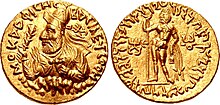

Shiva As Destroyer and/or Benefactor
Shiva has been adopted and merged with Buddhist deities. Left: Daikokuten is a Shiva-Ōkuninushi fusion deity in Japan;Right: Acala is a fierce Shiva adaptation.
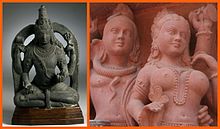
Oleograph by Raja Ravi Varmadepicting a Shiva-centric Panchayatana. A bearded Shiva sits in the centre with his wife Parvati and their infant son Ganesha; surrounded by (clockwise from left upper corner) Ganesha, Devi, Vishnu and Shiva. Shiva's mount is the bull Nandi below Shiva.

Chola dynasty statue depicting Shiva dancing as Nataraja i.e. "Lord Of the Dance" (Los Angeles County Museum of Art)
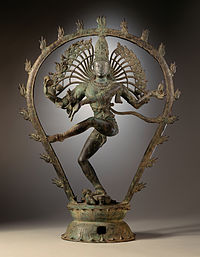
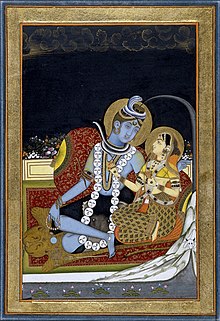
Shiva the ascetic;
Note: In today's world the focus of wonder has shifted to human beings themselves;
The descent of the Occidental sciences from the heavens to the earth (from seventeenth-century astronomy to nineteenth-century biology), and thier concentration today, at last, on man himself (in twentieth-century anthropology and psychology), mark the path of a prodigious transfer of the focal point of human wonder. Not the animal world. not the plant world, not the miracle of the spheres, but man himself is now the crucial mystery. - Joseph Campbell - Extract from the last chapter of "A Hero With A Thousand Faces"
Modern artist rendition of Shiva;


















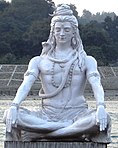
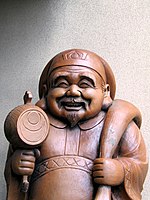
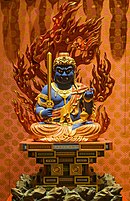


No comments:
Post a Comment